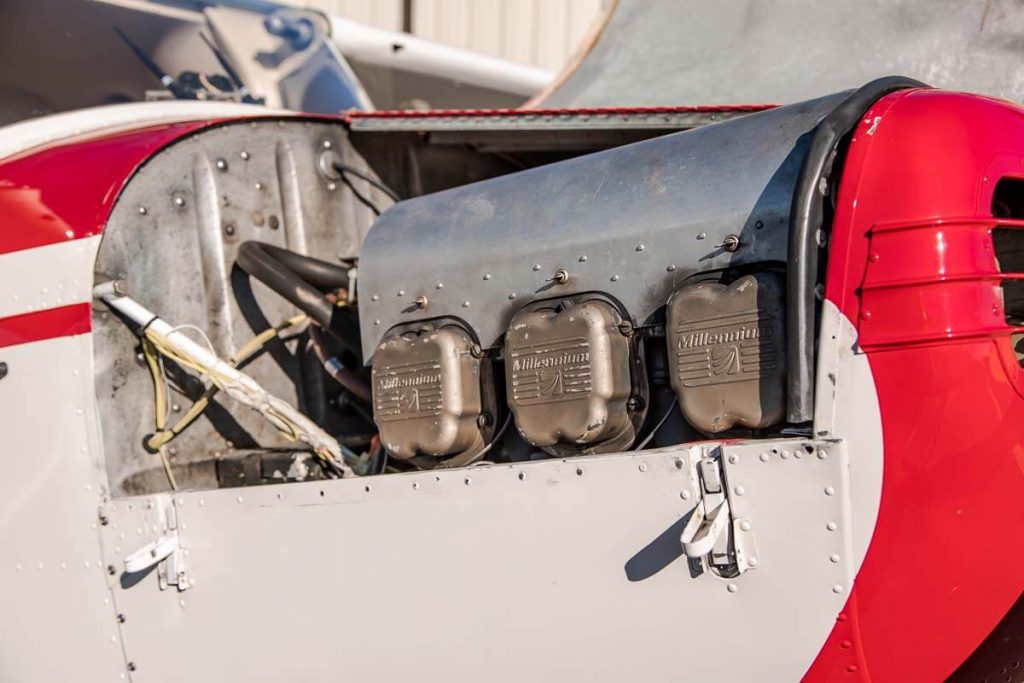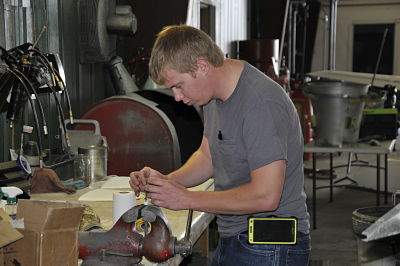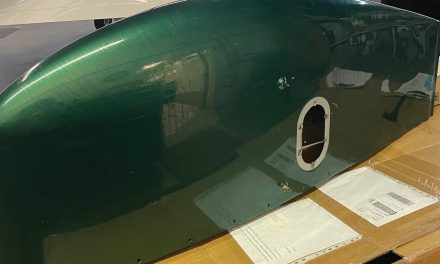
Whereas the party of the first part, acting as a surrogate for an A&P, herein-after referred to as the party of the second part …
Sorry, I’ve just spent a day doing research for this article and find myself conversing in lawyer-speak as a result. The other side effect is I seem to be nodding off occasionally. Reading Federal Aviation Regulation (FAR) Part 43 for several hours is highly recommended as a treatment for insomnia.
FAR Part 43 is the FAR most beloved by A&P rated maintenance technicians and their inspection authorized (IA) brethren because it spells out, in terse government sanctified language, exactly what is and isn’t required of them as they do their respective jobs.
For instance, it’s required by FAR Part 43, Appendix D that anyone performing an annual or 100-hour inspection shall thoroughly clean the aircraft and engine.
Really? Then why did your pride and joy come back from its annual with grease stains on the underside of the wings and remnants of an oil-draining episode in the lower cowling?
Because Appendix D (a) says: Each person performing an annual or 100-hour inspection shall, before that inspection, remove or open all necessary inspection plates, access doors, fairing, and cowling. He shall thoroughly clean the aircraft and aircraft engine.
The “thorough cleaning” occurs before the inspection. The FAA is interested in making certain the technician doesn’t miss anything during the inspection, not in making certain the technician displays his prowess as an aircraft detailer.
All of the FARs are like that, replete with tripwires and “gotchas.”
Unfortunately for us non-lawyer pilots, even if we have the wherewithal to patiently read through a FAR and really try to understand it, we can still be confused, which is why the FAA publishes advisory circulars. (More on that in a moment.)
FAR 43, Appendix A, Paragraph C sets out the kinds of preventive maintenance an owner/pilot may perform without the direct supervision of an airframe and powerplant rated technician. If you have at least a private pilot certificate and your aircraft is being operated only under FAR Part 91, you can perform the following preventative maintenance tasks. (Editor’s note: a few lines not pertinent to Cessna owners have been omitted. The complete list is available at www.faa-aircraft-certification.com.)
FAR 43 Appendix A Part C
- Removal, installation, and repair of landing gear tires.
- Replacing elastic shock absorber cords on landing gear.
- Servicing landing gear shock struts by adding oil, air, or both.
- Servicing landing gear wheel bearings, such as cleaning and greasing.
- Replacing defective safety wiring or cotter keys.
- Lubrication not requiring disassembly other than removal of nonstructural items such as cover plates, cowlings, and fairings.
- Making simple fabric patches not requiring rib stitching or the removal of structural parts or control surfaces.
- Replenishing hydraulic fluid in the hydraulic reservoir.
- Refinishing decorative coating of fuselage, wings, tail group surfaces (excluding balanced control surfaces), fairings, cowlings, landing gear, cabin, or cockpit interior when removal or disassembly of any primary structure or operating system is not required.
- Applying preservative or protective material to components where no disassembly of any primary structure or operating system is involved and where such coating is not prohibited or is not contrary to good practices.
- Repairing upholstery and decorative furnishings of the cabin, or cockpit when the repairing does not require disassembly of any primary structure or operating system or interfere with an operating system or affect the primary structure of the aircraft.
- Making small simple repairs to fairings, nonstructural cover plates, cowlings, and small patches and reinforcements not changing the contour so as to interfere with proper air flow.
- Replacing side windows where that work does not interfere with the structure or any operating system such as controls, electrical equipment, etc.
- Replacing safety belts.
- Replacing seats or seat parts with replacement parts approved for the aircraft, not involving disassembly of any primary structure or operating system.
- Troubleshooting and repairing broken circuits in landing light wiring circuits.
- Replacing bulbs, reflectors, and lenses of position and landing lights.
- Replacing wheels and skis where no weight and balance computation is involved.
- Replacing any cowling not requiring removal of the propeller or disconnection of flight controls.
- Replacing or cleaning spark plugs and setting of spark plug gap clearance.
- Replacing any hose connection except hydraulic connections.
- Replacing prefabricated fuel lines.
- Cleaning or replacing fuel and oil strainers or filter elements.
- Replacing and servicing batteries.
- Replacement or adjustment of nonstructural standard fasteners incidental to operations.
- The installations of anti-misfueling devices to reduce the diameter of fuel tank filler openings provided the specific device has been made a part of the aircraft type certificate data by the aircraft manufacturer, the aircraft manufacturer has provided FAA-approved instructions for installation of the specific device, and installation does not involve the disassembly of the existing tank filler opening.
- Removing, checking, and replacing magnetic chip detectors.
- The inspection and maintenance tasks prescribed and specifically identified as preventive maintenance in a primary category aircraft type certificate or supplemental type certificate holder’s approved special inspection and preventive maintenance program when accomplished on a primary category aircraft.
- Removing and replacing self-contained, front instrument panel-mounted navigation and communication devices that employ tray-mounted connectors that connect the unit when the unit is installed into the instrument panel, (excluding automatic flight control systems, transponders, and microwave frequency distance measuring equipment (DME)). The approved unit must be designed to be readily and repeatedly removed and replaced, and pertinent instructions must be provided. Prior to the unit’s intended use, an operational check must be performed in accordance with the applicable sections of part 91 of this chapter.
- Updating self-contained, front instrument panel-mounted Air Traffic Control (ATC) navigational software data bases (excluding those of automatic flight control systems, transponders, and microwave frequency distance measuring equipment (DME)) provided no disassembly of the unit is required and pertinent instructions are provided. Prior to the unit’s intended use, an operational check must be performed in accordance with applicable sections of part 91 of this chapter.
Watch out for “gotchas”
Doesn’t it seem like a lengthy but seemingly straightforward list? There are, however, some “gotchas” that aren’t readily apparent if you rely on the guidance provided by the FAR alone.
For instance, you can replace a landing gear tire or repack the grease in the wheel bearings, but many flight standards district office (FSDO) principal operations inspectors (POI) say you can’t remove and reinstall the brake assemble because the list doesn’t specifically say you can. So, if your local FSDO POI has that view, you’ll have to get an A&P to remove and reinstall the brakes, should that be necessary, before you can perform the allowed task.
Additionally, FAR 1, section 1.1 defines preventive maintenance as “simple or minor preservation operations and the replacement of small standard parts not involving complex assembly operations.” Virtually all FSDO POIs interpret that to mean the only thing you can remove to reach something is what’s specifically called out in Appendix A (c). If you have to disconnect and move something not specifically identified in the list in order to replace a filter on your engine, for instance, you can’t replace it even though the list says you can. Finally, there is the situation involving the FAA regional offices. Each FSDO reports to a regional office. I live in Kentucky and the Louisville FSDO, where I hung my aviation safety counselor hat, reports to the Southern Region Headquarters in Atlanta for a ruling, not the FAA national headquarters in Washington, D.C. Every local FSDO does the same thing, working with their regional headquarters and bypassing Washington unless there’s an extraordinary situation.
As a result, like the federal district court system, you can get rulings that are valid only as long as you are within a specific geographical area.
The result for the great-unwashed multitude of pilots is they can seek and receive a ruling on some issue from their local FSDO, such as FAR 43 A (c), and think they have the gospel according to the FAA. Then the day comes that they try to sell their aircraft into another region and some IA doing the prebuy inspection notices there are owner entries in the airframe and engine logbooks.
Maybe their local FSDO POI hates owner-performed maintenance and maybe the IA therefore flags what they consider to be a questionable logbook entry. They then tell the prospective new owner that the aircraft is not airworthy due to an unauthorized repair thereby killing the sale. Does it happen a lot? No. Can it happen? Absolutely.
Avoid later complications
So, what can you do to protect yourself yet do your own preventive maintenance?
First, limit yourself to things like changing or cleaning spark plugs, changing the engine oil and oil filter, replacing burned out landing lights and other maintenance that is unlikely to be questioned. Stay away from replacing side windows and other less routine items (even when they are allowed).
Secondly, study Advisory Circular 43-12A. This is the official Washington, D.C., FAA interpretation of what you can and cannot do under FAR Part 43 A (c). It trumps any reginal decision and can be relied on everywhere in the USA.
As you read it, pay particular attention to the proper way to make logbook entries when you perform any maintenance. It’s the paperwork that will trip you up in most FAR Part 43, A (c), cases, not the fact that you did the work.
Finally, the first time you perform a particular task, ask your local A&P to peer over your shoulder while you do the actual work. When you’re done, tell them what you are about to write in the logbook before you make the entry so they can help you avoid problems down the road.
In spite of the obstacles, working on your own aircraft is a great way to save money initially and to avoid costly repairs down the road. After all, who is going to take the most interest in the welfare of your flying machine — you or someone else?





